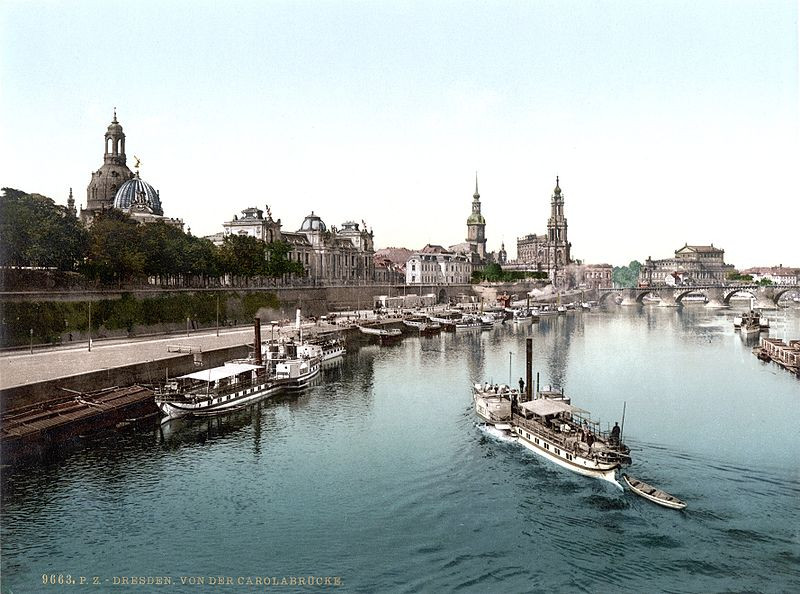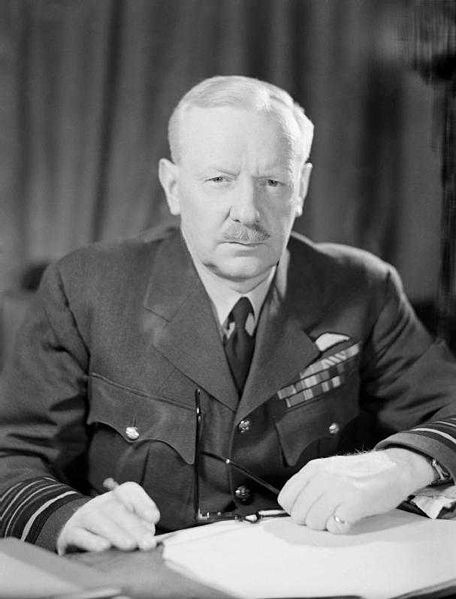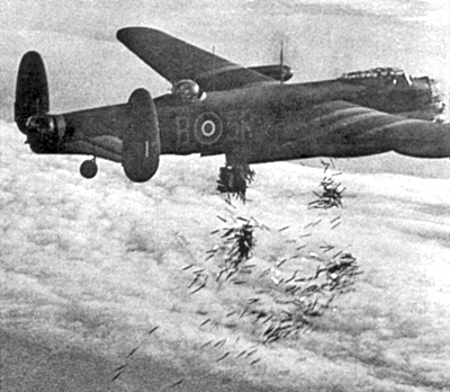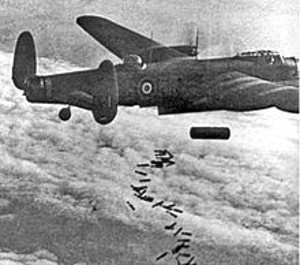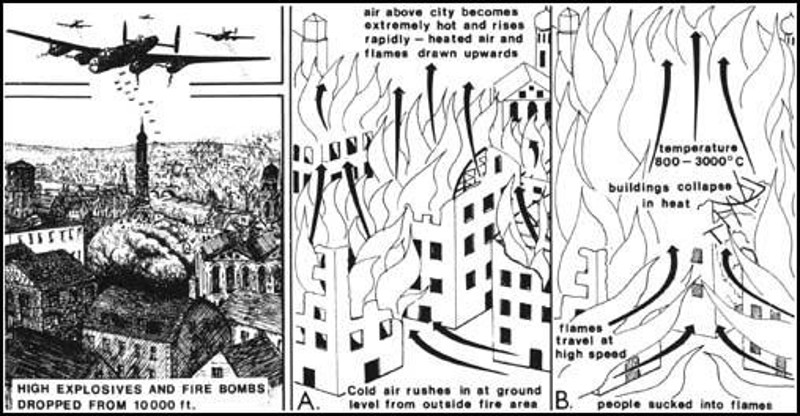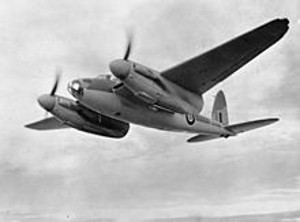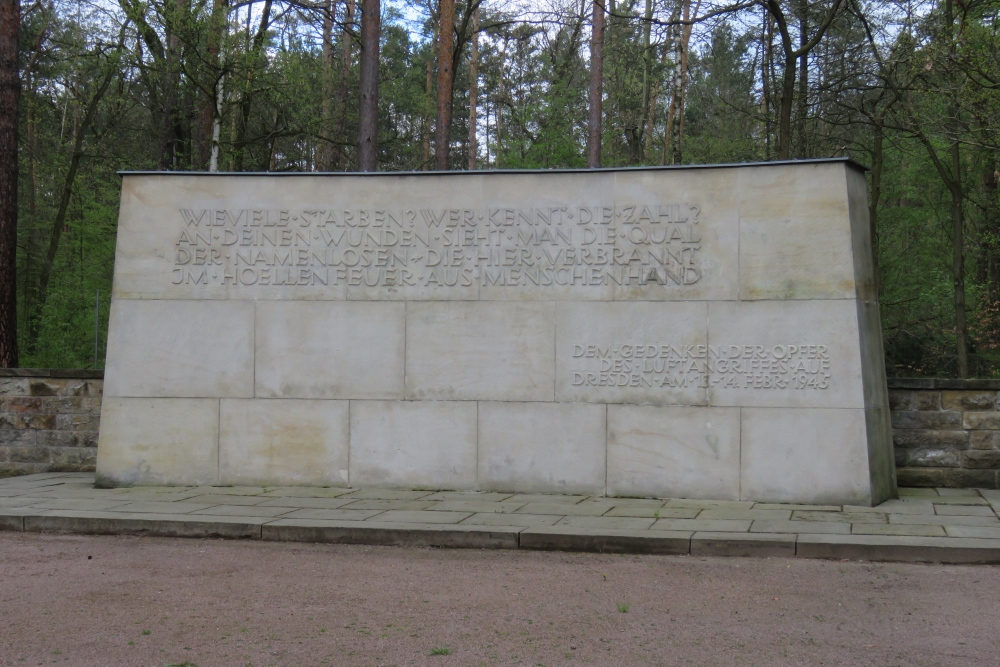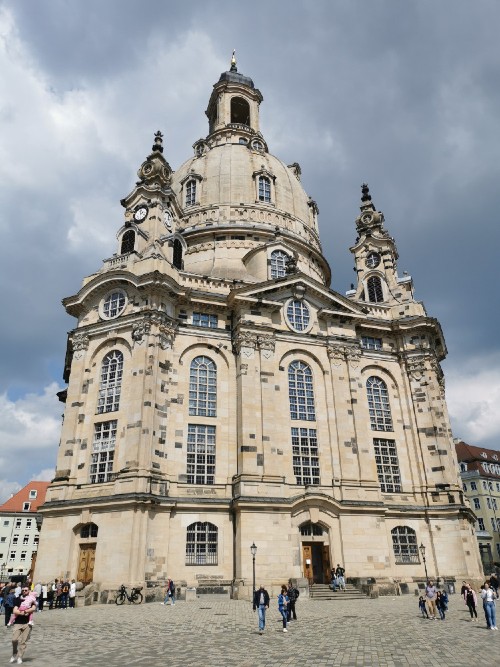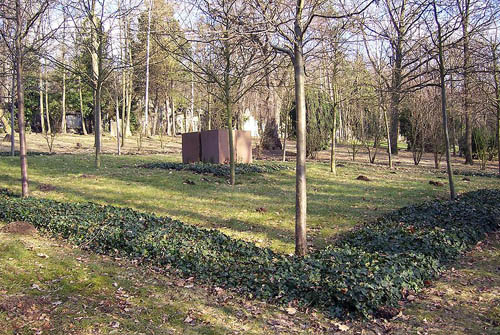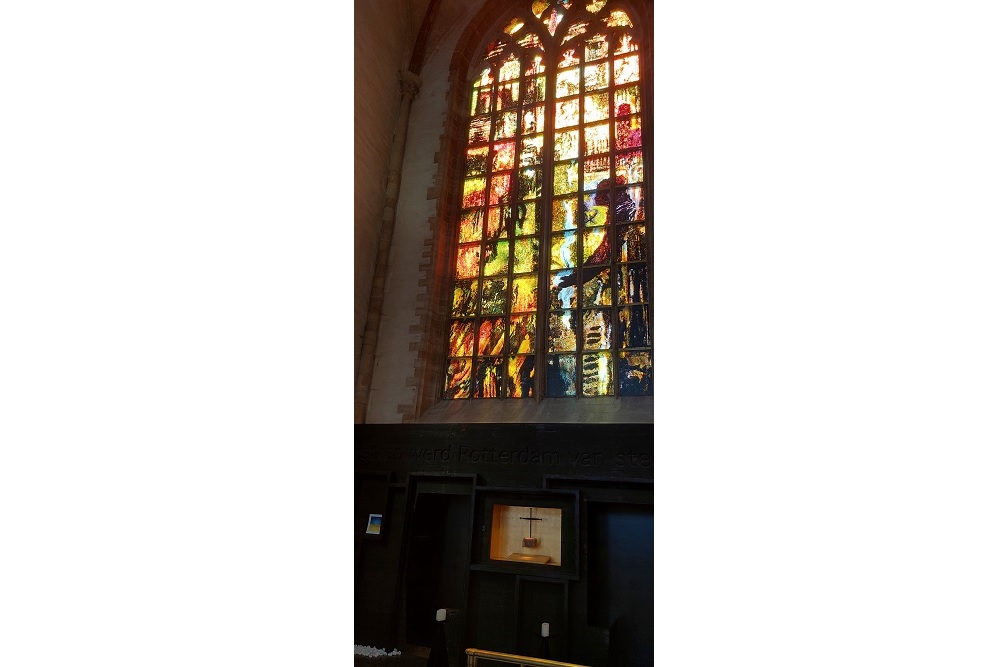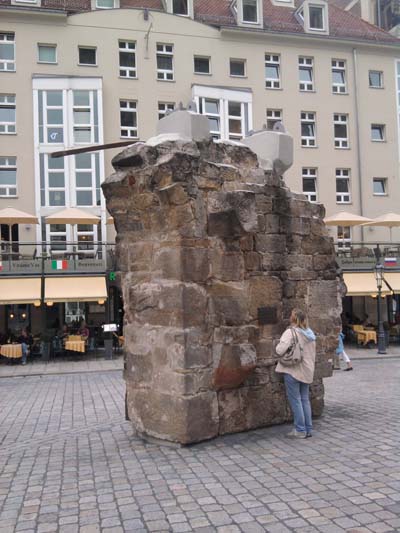Introduction
"German cities... will be subjected to an ordeal the like of which has never been experienced by a country in duration, severity and magnitude."
Churchill, 3 June 1942.
"In order to achieve the extirpation of nazi tiranny there are no lengths of violence to which we will not go."
Churchill, 21 September 1943.
Introduction
Dresden is the capital of Saxony. In the course of ages, the city became known as the Florence on the Elbe, Elbflorenz, an internationally renowned city of culture.In peacetime, the city had 630,000 inhabitants and ranked as the seventh city of Germany. The city, up until 1945, was spared the tragic fates of cities like Cologne, Essen, Hamburg and Berlin.There was not much industry and the industry that was present was not considered to be vital to the German war effort. Only the railroad marshalling yards had been attacked up until February, 1945.
Although residential areas had been bombed in other German cities and a firestorm had been created, by coincidence, in Hamburg in July, 1943, officially the targets remained weapon factories, U- boat yards, ammunition factories, synthetic oil plants, blast furnaces and oil refineries. Dresden had none of these. There were present, however, hundreds of thousands of refugees. The railroad marshalling yard was the third largest in Germany. The tracks from Berlin, Prague, Breslau,Warsaw,Leipzig and Nuremberg crossed each other here. Because of the rapidly shrinking nazi territory the marshalling yards even gained in importance.The USAAF, the American air force, already had attacked the marshalling yards several times.
Although strategically important objects were officially the target of the allies, the reality turned out to be much simpler. The following applied to Bomber Command:
"It must be emphatically stated that,with the exception of Essen, we never chose special industrial firms. The destruction of industrial installations always seemed to us to be a kind of bonus. Our target was always the city centre."
Harris in Bomber Command, 1948
Dresden was flooded with refugees from Pomerania, Silesia and Eastern Prussia. These Germans were on the run for the Red Army. The population had risen to 1,3 million and thus had more than doubled.The Germans had relocated the anti air artillery,the Flak, already in December, 1944 and January, 1945 to other places in Germany. In this way, Dresden had become a practically undefended city. It was widely believed that the allies would spare the city because of the art treasures and the 26,000 prisoners of war that lived in the neighbourhood and in the city itself. On the nearby Fliegerhorst 38/III Klotzsche remained some fighters and 18 Me 110 night fighters but these lacked fuel. Besides, the training of German pilots in this stage of the war was not thorough.
In February, 1945, Nazi Germany was reeling from all the blows it had received. The Ardennes offensive had turned out to be a costly and lost gamble.On 8 February, 1945, the allied campaign against the Reichswald began with operation Veritable and later Blockbuster and Grenade while on the eastern front, the Soviets had just concluded one of their most successful offensives, the Vistula-Oder offensive that had brought the Russians to 70 kms from Berlin.Next to the heavy losses that the Wehrmacht had suffered, the loss of the industrial area of Silesia was a hard blow for the German war effort. Further to the south, the front ran roughly a 100 kms from Dresden. By this fact the city had become hinterland for that front. Transports to the front had to cross the Elbe or go through Dresden.
The Red Army prepared for its final push to Berlin. According to a secret report of the Joint Intelligence Committee that was presented to Churchill on 21 January,1945, the war could be ended in April if the Soviet offensive succeeded. If not, the war could last into November.
Churchill thought that the heavy bombers could help the Russian offensive significantly. He deliberated the deployment with Secretary of State for Air Sir Archibald Sinclair. In this way the British could show that they had been faithful allies and in the same time they could show the Soviets what power Bomber Command had. On the conference from Jalta from 4 until 11 February, 1945 Stalin agreed with the British plans. Already before the conference Air Marshall Arthur Harris had received the order to prepare the mission.
Definitielijst
- Ardennes offensive
- Battle of the Bulge, “Von Rundstedt offensive“ or “die Wacht am Rhein“. Final large German offensive in the west from December 1944 through January 1945.
- Bomber Command
- RAF unit which controlled strategic and sometimes tactical bombing (as in Normandy)
- firestorm
- Happened spontaneously in Hamburg in 1943. This was the ultimate goal of each bombardment. The firestorm could no longer be extinguished and burned down everything in its path. Surface temparatures of 800-1,000 degrees Celcius and wind speeds upto 240 km/hour, so double hurricane force, were reported. Bomber Command only succeeded a few times in creating the desired firestorm, that is in Hamburg on 27 July 1943, Kassel on the 22 October 1943, Darmstadt on 11 September 1944 and Dresden on 13-14 February 1945. Bomber Command always selected the medieval city centres (Altstadt) as target because of the many high wooden buildings and narrow streets.
- Flak
- Flieger-/Flugabwehrkanone. German anti-aircraft guns.
- nazi
- Abbreviation of a national socialist.
- offensive
- Attack on a smaller or larger scale.
- Red Army
- Army of the Soviet Union.
- Wehrmacht
- German armed military forces, divided in ground forces, air force and navy.
Images
Prior bombing
Strategic bombing
During the Great War cities had already been bombed, albeit on a small scale.During the Interbellum the thought that the bomber could independently decide a war gained ground.The bomber always gets through. The Americans and the British were the first to elaborate the concept of strategic four engined bomber fleets. They wanted to bring the war to the heart of the enemy and thus rob him of the capacity to wage war. This idea was a consequence of the large battles of attrition from the Great War like the battles of Verdun, the Somme and Passchendaele. In stead of sacrificing millions of the best young men in senseless campaigns of slaughter it would be wiser to destroy the enemy's weapon factories and oil refineries.
"Although deranged theorists concerning the future air war were everywhere, their ideas were only accepted and implemented in the United Kingdom."
Alexander McKee
Stanley Balwin, leader of the British Conservative Party, said as early as 10 November, 1932 in the House of Commons that no boundaries would be set, in future wars, to bombers over enemy cities. International legislation did not exist on this specific subject.Great Britain wanted to control her vast empire,that covered one fifth of the earth and which was at its peak during the Interbellum, with an air force.This was much more cost effective than to mobilize an army, transport it and sustain it in vast areas with a hostile population. The British had had,among others, experience with mutinies in India and a difficult population in mountainous areas like Afghanistan and Pakistan and had had a hard time fighting the Boers where they faced well equipped and well organized mobile guerillas. Long before the German bombing of Guernica on 26 April, 1937, during the Spanish Civil War, the Royal Air Force had executed bombing attacks on Iraqi insurgents. During these raids, "savage tribes" were targeted where civilians were deliberately bombed. This happened during the 1920 Iraqi Revolt. The use of aircraft gave the British and Indian troops the upper hand and played a large role in ending the revolt.
A sliding scale: The road to "moral bombing" and Dresden
During the Spanish Civil War, on 26 April 1937, Guernica was bombed by the German Condor Legion. It was the first air raid on civilians in Europe.There was world wide horror in response to this carnage from the air. The Nazis had no hesitation transgressing moral boundaries and saw especially the effect of the attack and the effect on the morale of the Republican troops. The German bombing of Warsaw on 25 September 1939 was the first major air attack of the Second World War. Warsaw was, however, a defended city. After a German bombardment of Scapa Flow during which a British civilian died, Bomber Command attacked Hörnum in the night of 19 to 20 March,1940. The bombing of Rotterdam on 14 May, 1940 took place during fierce fighting in the city. Although the number of civilian dead was significant, around 1,000, according to international law this was not a terror attack. The Germans threatened, however, that Utrecht and other cities would share the fate of Rotterdam if Holland did not surrender at once. Because of the impact of the attack, the Dutch government initially spoke of 100,000 dead which was later adjusted to 30,000, the RAF was permitted to attack beyond the Rhine.This amounted to,for the time being, the Ruhr area.Blast furnaces and public utilities were from now on on the list of targets.
Bomben auf England. Battle of Britain.10 July-31 October 1940
After the surrender of the Low Countries, the retreat from Dunkirk and the capitulation of France, German peace terms were turned down by the British. There was much opposition in Great Britain against Churchill's decision to fight on. The army, it is true, had escaped for the largest part, (240,000 British and 100,000 others) but had had to leave behind all heavier equipment like guns, tanks and trucks. The RAF was considerably weaker than the Luftwaffe. Many voices were raised that called for an agreement with the Germans. The German offer, however, was declined and the Luftwaffe prepared itself to force Great Britain to its knees through the air. Initially, shipping in the Channel was targeted, followed by radar stations and airfields from Fighter Command.
On 20 July, Churchill asked Air Marshall Portal when the RAF could mount an attack on Berlin at the shortest possible notice. Portal answered that when the British would do so, Hitler would lift his embargo on attacking British cities. Besides, the nights were too short to fly to Berlin. On 24 August, a few bombs were dropped on London by a German bomber that was lost. On 25 August, Churchill insisted that an attack on Berlin by 100 bombers be executed. That same night the attack took place.Several other bombing raids on a smaller scale were executed during that time.
On 4 September, Hitler held his Winterhilferede in the Sportpalast in Berlin in which he announced that from that moment on, British cities would be bombed.He gave the order to attack London.The Blitz was born.In operation Loge, during 57 consecutive nights starting with 7 September 1940, London was bombed.
"In this way the British come, as you know, during the night and drop,at random and without policy, bombs on living quarters, farms and villages.I have refrained from answering this for three months in the conviction that they would stop this devilment (Unfug). Mister Churchill interpreted this as a sign of weakness. One understands that we will answer night after night (…) When the RAF drops four tons we will drop 400 tons on England." Hitler, 4 September 1940.
Because the attacks on the airfields of Fighter Command were suspended, it gained some air and got time to recover. The attacks on the British cities only strengthened the British resolve to fight on.Churchill had Hitler where he wanted him and scored a political and military victory. The English peace camp was weakened while Fighter Command and with it Great Britain was saved.
Definitielijst
- Bomber Command
- RAF unit which controlled strategic and sometimes tactical bombing (as in Normandy)
- capitulation
- Agreement between fighting parties concerning the surrender of a country or an army.
- Condor Legion
- Name of German air force (mainly) units that fought alongside General Franco during the Spanish civil war from 1936-1939.
- Interbellum
- “Latin: Between war”. Years between the Great War and World War 2.
- Luftwaffe
- German air force.
- moral
- The will of the troops/civilians to keep fighting.
- radar
- English abbreviation meaning: Radio Detection And Ranging. System to detect the presence, distance, speed and direction of an object, such as ships and airplanes, using electromagnetic waves.
- RAF
- Royal Air Force. British air force
- raid
- Fast military raid in enemy territory
- Spanish Civil War
- Fierce and cruel civil armed conflict in Spain from 1936 to 1939 between left (from anarchic to liberal) and right (church, nobility and army). In 1936 the fascist-oriented general Franco started military uprisings. With the help of Hitler and Mussolini he beat the republicans who vainly were supported by the International Brigade.
Images
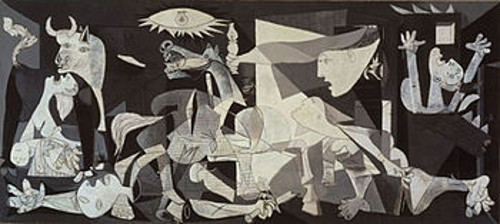 Picasso's Guernica Source: wikipedia.
Picasso's Guernica Source: wikipedia. Zadkine's monument of the bombing of Rotterdam Source: wikimedia.
Zadkine's monument of the bombing of Rotterdam Source: wikimedia.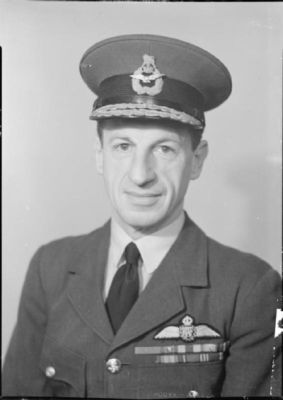 Air Marshall Charles Portal Source: Imperial War Museum.
Air Marshall Charles Portal Source: Imperial War Museum.The British bombing offensive. Rules of war on a further sliding scale
The "London Blitz"and the eight months lasting attacks on other targets in Great Britain, with its culmination in the bombing of Coventry on 14 November 1940, did much to roughen the British public opinion. Hitler used terms as "ausradieren", or "annihilate by radiation" and "coventrieren", heavily bombing like Coventry.After the bombing of Coventry, a secret experimental terror attack on Mannheim was approved.This bombing of Mannheim was the first case of "area bombing", where a complete area was bombed in stead of a specific object.In the night of 16 to 17 December, 1940,the attack ,in which 45 % of the city was destroyed, was executed. The attack led to a new invention, the bomber stream. This was a method to fight the effectiveness of the Kammhuberlinie, the German night fighter line where night fighters were led to their targets by radar stations within a specific area. Another limit had been crossed.
The new technique became known as area bombing , saturation bombing, carpet bombing, obliteration bombing and moral bombing. The receiving side called it terror bombing.Joseph Goebbels, the nazi Minister of Propaganda, called the RAF men from Bomber Command "Churchill's Mordbuben", Churchill's murdering lads,and "Luftgangster" that destroyed European culture cities. Some bomber crews were lynched by the frustrated German population. As the war progressed and the scale of the bombing intensified, this happened more often.
In the Butt report of 18 August 1941, in which the British bombardments up until then were judged, it became clear that the effect of the nightly British bombings was minimal. Eventually,this would lead to the area bombing directive (nr.22) of 14 February,1942.
"The primary object of your operations should now be focussed on the morale of the enemy civil population and in particular of the industrial workers. The aiming points are to be the built up areas. Not e.g. the dockyards or aircraft factories. This must be made quite clear, if it is not already understood." Air Marshall Charles Portal, February 1942.
In that same month a new Commander-in-Chief of Bomber Command was appointed, Air Marshall Arthur Harris. Following quotes describe the mentality and the policy of the leading persons.
"I hope that the new Supreme Commander of Bomber Command is aware that our targets in future will not only be the factories in the respective towns but the surrounding civilian areas, the worker's houses, the centres of population."
Churchill to Harris.
"The Nazis entered this war under the rather childish delusion that they were going to bomb everyone else, and nobody was going to bomb them. At Rotterdam, London, Warsaw and half a hundred other places, they put their rather naive theory into operation. They sowed the wind, and now they are going to reap the whirlwind." Harris,1942.
"The aim of the Combined Bomber Offensive...should be unambiguously stated [as] the destruction of German cities, the killing of German workers, and the disruption of civilised life throughout Germany.... the destruction of houses, public utilities, transport and lives, the creation of a refugee problem on an unprecedented scale, and the breakdown of morale both at home and at the battle fronts by fear of extended and intensified bombing, are accepted and intended aims of our bombing policy. They are not by-products of attempts to hit factories." Harris, October 1943.
The policy was in place.The intention was clearly defined.A new Air Marshall had been appointed. New bombers like the Lancaster and Halifax rolled off the assembly line. They had higher speed, greater range and a much heavier payload than the Stirling and Wellington. The engineers thought hard of methods to inflict maximum damage to the German cities.
A few months later the first so called 1,000 bomber raid took place on Cologne in the night of 30 to 31 May, 1942. This was operation Millenium. It was the first use of the bomber stream. A new milestone had been reached. Two days later Essen received the same treatment.
More than a year later, on 27 July 1943, the RAF succeeded for the first time, by coincidence, in creating a firestorm. The circumstances over Hamburg were perfect. The Mosquito pathfinders transmitted windspeed and wind direction to the bombers. The Hamburg area had been very dry the days before. The air was already warm because of the summer heat. The German Flak and night fighters were blinded by a new allied invention,Windows, a radar jamming thing known as chaff. The metal strips interfered with the German radar.Because of this the Flak could not fire and the bombers could fly in uninterrupted and drop their bombs at the exact planned time and place. The German fire brigade was hampered by the effects of the cookies and the HE bombs with delayed fuses. Because of the clear weather and the use of the H2S ground radar the target was accurately found and well marked.Because of this the bombs were dropped concentrated in time and place on their intended target. From 24 until 30 July, 1942, the city was attacked by the RAF and the USAAF.Hamburg received a crippling blow. 42,000 German civilians were killed, more than the entire number of British casualties during the Blitz against Great Britain. The German Minister of Armament and Munition wrote that Germany would have been compelled to surrender if the allies could deliver another four or five blows of that magnitude.
In the course of the war the machinery and the methods of Bomber Command were further refined. Elektronic navigation aids as GEE, Oboe, G-H and the H2S ground mapping radar helped to improve precision.Tactical improvements like the implementation of the Pathfinder Force, developed against the will of Harris, also improved precision. In 1945,Bomber Groups like No.5 Group were able to bomb a sector in a fan like shape. By variations in time, height and course of the bombers, a maximum payload was ensured in a limited space and time. This maximized the effect of the incendiary bombs. This also happened in Dresden with the base of the fan being the DSC soccer stadium in the Ostragehege, which was easily identifiable with the ground mapping radar H2S.
Definitielijst
- area bombing
- Aerial bombardment targeted indiscriminately at a large area. Prohibited since 1977 by the Geneva Convention. Also known as carpet bombing, obliteration bombing and moral bombing.
- Bomber Command
- RAF unit which controlled strategic and sometimes tactical bombing (as in Normandy)
- brigade
- Consisted mostly of two or more regiments. Could operate independently or as part of a division. Sometimes they were part of a corps instead of a division. In theory a brigade consisted of 5,000 to 7,000 men.
- carpet bombing
- The opposite of precision bombing. Also known as area bombing, saturation bombing and obliteration bombing.
- firestorm
- Happened spontaneously in Hamburg in 1943. This was the ultimate goal of each bombardment. The firestorm could no longer be extinguished and burned down everything in its path. Surface temparatures of 800-1,000 degrees Celcius and wind speeds upto 240 km/hour, so double hurricane force, were reported. Bomber Command only succeeded a few times in creating the desired firestorm, that is in Hamburg on 27 July 1943, Kassel on the 22 October 1943, Darmstadt on 11 September 1944 and Dresden on 13-14 February 1945. Bomber Command always selected the medieval city centres (Altstadt) as target because of the many high wooden buildings and narrow streets.
- Flak
- Flieger-/Flugabwehrkanone. German anti-aircraft guns.
- GEE
- Allied radio guided navigation system to direct bombers to their intended targets.
- H2S
- Groundscanning radar on board of a bomber.
- heat
- High-explosive anti-tank warhead. Shaped charge projectile to punch through armour. Used in e.g. bazooka or in the Panzerfaust.
- moral
- The will of the troops/civilians to keep fighting.
- moral bombing
- Bombings aimed at enemy workers and other civilians to demoralize them or to break their morale in an attempt to have them revolt against the authorities.
- nazi
- Abbreviation of a national socialist.
- Oboe
- Allied aerial blind bombing targeting system introduced early 1943, to guide bombers to their targets. Worked with echoes that were broadcast by the aircraft itself and therefore signals of the aircraft could be detected by the enemy. Worked by means of two ground stations, the CAT, which determined if the aircraft was flying on course and the MOUSE which indicated if the aircraft had arrived above target. Disadvantages were the limited range (270 miles) and the fact that the aircraft could be detected. Because of these disadvantages mainly Pathfinders Mosquito units used Oboe.
- Offensive
- Attack on a smaller or larger scale.
- Pathfinder Force
- Unit flying ahead of the bombers to locate and mark the target with flares to enable the following bombers to drop their bombs at the pre-set time, height and course from the target.
- Propaganda
- Often misleading information used to gain support among supporters or to gain support. Often used to accomplish ideas and political goals.
- radar
- English abbreviation meaning: Radio Detection And Ranging. System to detect the presence, distance, speed and direction of an object, such as ships and airplanes, using electromagnetic waves.
- RAF
- Royal Air Force. British air force
- raid
- Fast military raid in enemy territory
Images
 Churchill visits the ruins of the cathedral of Coventry in September, 1941 Source: wikipedia.
Churchill visits the ruins of the cathedral of Coventry in September, 1941 Source: wikipedia. A part of the map of the Kammhuber line stolen by a Belgian agent and passed on to the British in 1942. The line and the locations of nightfighters are shown Source: wikipedia.
A part of the map of the Kammhuber line stolen by a Belgian agent and passed on to the British in 1942. The line and the locations of nightfighters are shown Source: wikipedia.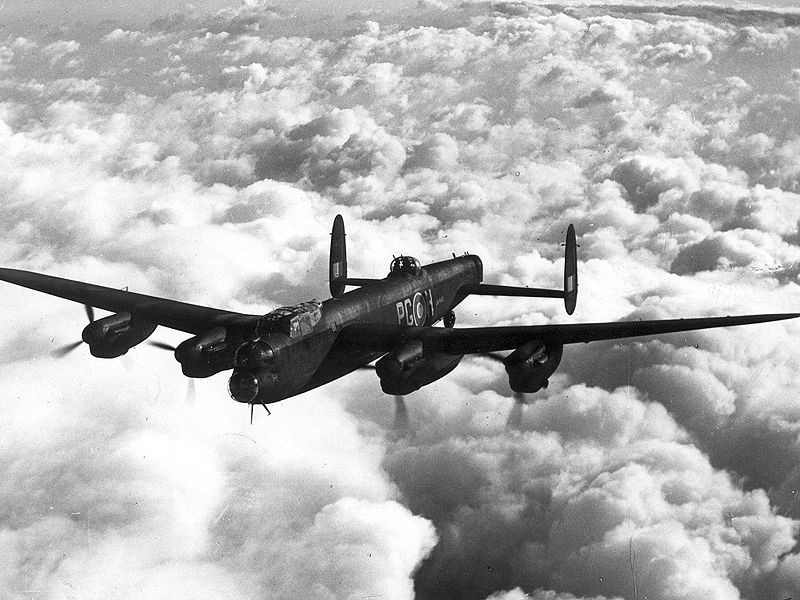 Avro Lancaster Source: wikimedia.
Avro Lancaster Source: wikimedia.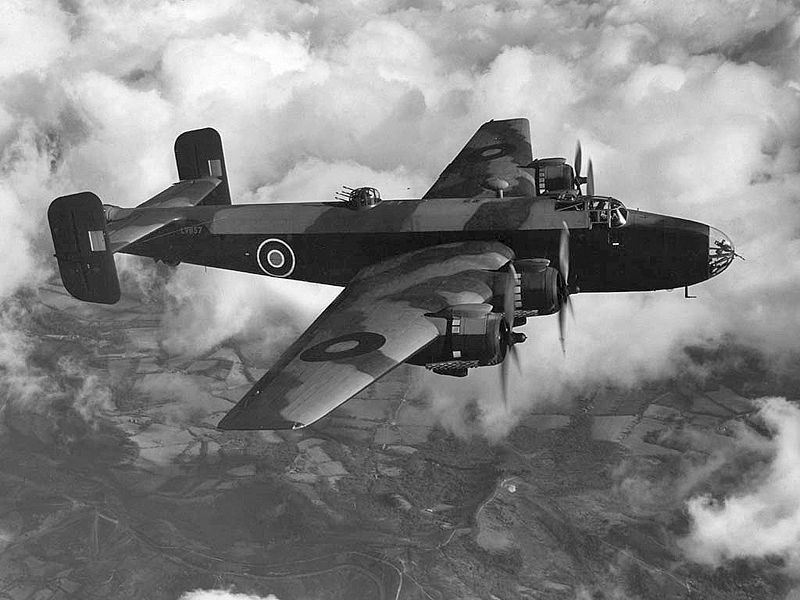 Handley Page Halifax Source: wikimedia.
Handley Page Halifax Source: wikimedia. On the left side the effect on the radar screen through the use of chaff is shown. Source: wikipedia.
On the left side the effect on the radar screen through the use of chaff is shown. Source: wikipedia.Anatomy of a typical bombardment of Bomber Command
In 1945, Bomber Command had perfected its methods for bombing in such a way that an effective machine of destruction was created. No. 5 Group took care of the first action at Dresden.First the pathfinders would fly to their target while the first wave of bombers followed further behind. The Pathfinders marked the target with flares.This was a precise job which was coordinated by the Master Bomber. Soon after, the arriving bombers dropped their payload with the aim of concentrating the bombs in time and space. First High Capacity/HC aerial mines, the so called "cookies"were dropped.These were large cilynders of 4,000 lbs (1,800kgs), 8,000 lbs (3,600kgs) or 12,000 lbs (5,400kgs). Three quarter of the weight consisted of the high explosive amatol. The rest of the weight consisted of a relatively thin side.The pressure wave of the blast of the cookies tore roofs from homes and pushed in windows and doors of the buildings. In this way a chimney like construction was created.At the same time, general purpose 500 lb (227 kg) bombs were dropped, sometimes with a delay fuse.These bombs caused holes in the roads and contributed to the general destruction and made it difficult to use the roads. Because of the time fuses, fire fighting and salvation was hampered. The GP bombs would not explode on impact but would fall through several storeys of buildings, penetrate the ground and then explode. By doing this also gas- and electricity ducts were damaged. This contributed to the fires and and hampered fire fighting because the pressure in the water ducts decreased. Frequently,for this reason,preventive ponds were dug.
After this incendiary bombs were dropped.The intention was to drop as many incendiaries as possible so that fire fighting would become more difficult and it was hoped that the small fires would unite to one big fire and eventually to a firestorm.Some incendiaries had charges in them in order to disrupt the fire fighting. The first wave would leave the area and the stricken city would hear the safe signal, if the installation was still intact.The fire department tried to extinguish the fires. The fire departments of the wide surrounding area would rush to the burning city. Rescue workers would try to save victims. The citizens would leave the air raid shelters.
Two to three hours later a much larger group of bombers would arrive for the main attack. It was hoped to catch the fire fighters and rescue workers in the open air or to force them to find shelter. The civilians would reenter their shelters terrified. The second wave would only drop firebombs. The burning city was visible from a large distance. The aim was to create a firestorm.When this storm was a fact nothing could stop it.The storm could not be extinguished and killed the people who had taken cover in the basements of their houses. The people would suffocate slowly due to exposure to carbon monoxide. The stack of coals lay in the cellars and would start to release carbon monoxide because of rising temperatures. Lack of oxygen and smoke poisoning took their toll.The heat of the fire could reach 800-1,000 degrees centigrade.Glass, tarmac and metal melted.Because of the upward motion of the hot air,colder air from the surroundings was sucked in which envigorated the fire.Windspeeds of up to 240 km/hour were reported. This was twice the force of a hurricane. Trees would snap off. People were sucked into the fire. Eventually the firestorm would reach a surface of 21 square kilometers and a height of 300 meters. The firestorm would only end when all flammable material was consumed.
Definitielijst
- Bomber Command
- RAF unit which controlled strategic and sometimes tactical bombing (as in Normandy)
- firestorm
- Happened spontaneously in Hamburg in 1943. This was the ultimate goal of each bombardment. The firestorm could no longer be extinguished and burned down everything in its path. Surface temparatures of 800-1,000 degrees Celcius and wind speeds upto 240 km/hour, so double hurricane force, were reported. Bomber Command only succeeded a few times in creating the desired firestorm, that is in Hamburg on 27 July 1943, Kassel on the 22 October 1943, Darmstadt on 11 September 1944 and Dresden on 13-14 February 1945. Bomber Command always selected the medieval city centres (Altstadt) as target because of the many high wooden buildings and narrow streets.
- heat
- High-explosive anti-tank warhead. Shaped charge projectile to punch through armour. Used in e.g. bazooka or in the Panzerfaust.
- Master Bomber
- Specialized plane leading the marking of the territory which could transmit corrections in order to increase the accuracy of the bombing to hit the target as close as possible
- raid
- Fast military raid in enemy territory
Images
The fatal night
First RAF attack wave in the night from 13 to 14 February 1945
An internal RAF memo from january 1945 spreads some light on the reason for the bombing:
"Dresden, the seventh largest city in Germany and not much smaller than Manchester, is also far the largest unbombed built-up the enemy has got. In the midst of winter with refugees pouring westwards and troops to be rested, roofs are at a premium. The intentions of the attack are to hit the enemy where he will feel it most, behind an already partially collapsed front, to prevent the use of the city in the way of further advance, and incidentally to show the Russians when they arrive what Bomber Command can do."
On Faschingsdienstag, a kind of Mardi Gras, 13 February 1945 at 21:45 hour, the175th air alarm of the war sounded in Dresden.The people went into the basements of their houses or living blocks and in the few available air raid shelters. The attacks started with a clear, cloudless night sky. At 22:03 hour the inner city was demarcated with magnesium flares (called „Christmas trees" by the Germans) by Lancasters from No. 83 Squadron, a Pathfinder unit. Two minutes later nine Mosquitoes dropped red flares on the well visible DSC soccer stadium at the Ostragehege northwest of the city centre.From 22:13 until 22:28 hour the first bombs were dropped. 244 Lancasters of No.5 Group destroyed the buildings with 529 airmines, the so called "cookies" and 1,800 GP- and incendiary bombs with a total weight of 900 ton. They landed southwest of the aiming point (DSC stadium) in a 45 degree fan between thelarge bend of the Elbe in the west of the city, the industrially built up Ostragehege (nowadays the trade fair) and the central station or Hauptbahnhof 2,5 kms further.
In these 15 minutes three quarters of the old city of Dresden was set ablaze.Pin point hits on separate buildings were neither possible nor intended during these nightly attacks by the RAF.The carpet bombing was intended to destroy the complete Altstadt over a large area.The flames of the burning inner city after the first wave were visible in a wide area around. Some fires burnt for four days.
Second RAF wave in the night of 13 to 14 February
Almost three hours after the end of the first wave, at 01:23 hour, the second wave consisting of 529 Lancasters from No.1, No.3 and No.8 Groups from the RAF and the No. 6 Group from the Canadian air force or RCAF attacked. Until 01:54 hour they dropped over 650,000 incendiaries, a total of 1,500 ton, over an area from Löbtau to Blasewitz and from the Neustadt until Zschertnitz. The fires that were caused earlier served as a reference point for the following bombers according to testimonies of crew members from the second wave.Their bombs also hit the meadows along the Elbe river and the Großer Garten where many people had fled.The „Frauenklinik Pfotenhauerstraße" from the city hospital Dresden-Johannstadt and the Diaconesseninstitute in the Neustadt were badly damaged.Both bombings hit a surface of approximately 15 square kilometers.The second wave destroyed the technical means of the despatched fire department and impeded further fire fighting, so that the countless dispersed fires joined quickly in a hurricane- like firestorm. This firestorm destroyed entire rows of streets and city blocks. In the extreme heat from 800-1,000 degrees centigrade, tarmac, glass and metal melted.The strong airflow, up to 240 kmh, threw over cars and people and drew them into the fire. They burned to death, died of heat stroke or air pressure or suffocated in the shelters because of the fumes of the fire.Whoever managed to escape from the basements was exposed to the firestorm and exploding bombs that lay in the streets with delayed fuses.
Attacks by day by the USAAF on 14 and 15 February 1945
The two waves of the previous night were followed by an attack from12:17 until 12:31 hour by 311 to 316 B-17 bombers and 100-200 escorting fighters from the USAAF. Aided by radar because of a clouded sky, they dropped 1,800 general purpose bombs with a total of 475 ton and 136,800 incendiaries with a total weight of 297 ton. Their targets were some armament industries and once again the railway station and the Reichsbahnausbesserungswerk Dresden in Friedrichstadt. The hospital in that area was also hit next to adjacent parts of the city.Because of an active weather front two groups deviated some 100 kms to the southwest and bombed Prague by accident.In Neustadt,35 kms far from Dresden, a rain of ashes descended on 14 February that was caused by the bombing of the day before.
Many survivors reported that Mustang escorting fighters regularly strafed civilians. It was said that the salvoes fired by the fighters during air duels that landed on or near the civilians might have caused them to think that they were being fired upon. As far as is known, however, no air to air duels were fought over Dresden.
The American Kurt Vonnegut, author of Slaughterhouse Five from 1969, was in Dresden and was deployed to recover bodies from the various cellars.He was one of 26,000 POWs that were housed in or near Dresden at the time. He said that he was attacked by US fighters. Ofcourse it remains difficult to identify between friend and foe when flying low at 600 kmh in a war zone.
On 15 February around 10:15 hour the burnt out Frauenkirche collapsed. From 11:51 until 12:01 hour another attack took place by 211 American B-17 bombers. With poor visibility they dropped another 460 ton of bombs, spread out between the area of Meißen and Pirna.
Definitielijst
- Bomber Command
- RAF unit which controlled strategic and sometimes tactical bombing (as in Normandy)
- carpet bombing
- The opposite of precision bombing. Also known as area bombing, saturation bombing and obliteration bombing.
- firestorm
- Happened spontaneously in Hamburg in 1943. This was the ultimate goal of each bombardment. The firestorm could no longer be extinguished and burned down everything in its path. Surface temparatures of 800-1,000 degrees Celcius and wind speeds upto 240 km/hour, so double hurricane force, were reported. Bomber Command only succeeded a few times in creating the desired firestorm, that is in Hamburg on 27 July 1943, Kassel on the 22 October 1943, Darmstadt on 11 September 1944 and Dresden on 13-14 February 1945. Bomber Command always selected the medieval city centres (Altstadt) as target because of the many high wooden buildings and narrow streets.
- heat
- High-explosive anti-tank warhead. Shaped charge projectile to punch through armour. Used in e.g. bazooka or in the Panzerfaust.
- radar
- English abbreviation meaning: Radio Detection And Ranging. System to detect the presence, distance, speed and direction of an object, such as ships and airplanes, using electromagnetic waves.
- RAF
- Royal Air Force. British air force
- raid
- Fast military raid in enemy territory
- Squadron
- A military unit in the Belgian navy usually six to eight small ships operating together under one command. The smallest military unit in the Dutch air force of about 350 men. In most countries is the designation of a military unit thesize of a company. It is either an independent unit, such as a battery, or part of a bigger Calvary unit. In the air force it is the designation of a unit of aircrafts.
Images
Repercussions of Dresden
The Germans were busy recovering, transporting and cremating the bodies for two weeks.First they lay in the street in long rows for identification.Some bodies were melted to the burning and melting tarmac. Sometimes the bodily remains were charred to a mere 25%. Initially it was tried to bury the corpses in a mass grave but this turned out to be impossible. On the Altmarkt the bodies were laid on tram rails in order to be cremated.The basis of the funeral pyre was ten by ten meters. The bodies were laid on the pyres. When the pile was three meters high the bodies would be ignited by flamethrowers. These pyres were used during ten days.
The Germans quickly claimed that hundreds of thousands of civilians had been killed. The nazis wanted to exploit the massacre in order to incite the people to even harder resistance.
"Controlled returns of the Dresden order police (Ordnungspolizei) until 20 March 1945 report a total of 202,000 dead, mainly women and children. 30% of them is entirely identified.When including the missing this would render a number of 250,000 to 300,000 victims." Alexander MacKee.
On 30 April 1945,the Ia (Erster Generalstabsoffizier) of Dresden, Oberstleutnant i. G. Mathes reported to the Führerhauptquartier that the total number of deadly victims had been adjusted to 254,000. "Of these, 36,000 are fully identified, 50,000 have been partially identified with help of wedding rings and 168,000 can't be identified any more."
The International Red Cross estimated a total of 275,000 killed.On 15 March, the Dresden chief of police said that 200,000 bodies had been recovered from under the debris. The Dutch journalist and historian G.B.J. Hiltermann mentioned a number of 130,000 dead in 1984. Current estimates vary between 22,700 and 25,000 civilian deaths.This is 10% of the initial estimate.A problem with all estimates is the extreme heat of the fire that made many corpses disappear and the large numbers of unregistered refugees that were in the city.
By the way,this percentage differs greatly from the percentages that were estimated following the bombing of Rotterdam on 14 May, 1940. I use this comparison because both bombings are infamous and the one in Rotterdam was carried out by the Luftwaffe at the beginning of the war and the other was carried out by allied air forces at the end of the war. In Rotterdam, initially a death toll of 100,000 was feared and reported. This was adjusted to 30,000 until it became clear that less than 1,000 people had actually been killed. From 100,000 deaths to (less than) 1,000 is 1 % . The most cautious estimates on Dresden are beneath 10 % of the initially reported number of deaths.
Definitielijst
- heat
- High-explosive anti-tank warhead. Shaped charge projectile to punch through armour. Used in e.g. bazooka or in the Panzerfaust.
- International Red Cross
- Name of a complex of co-operating humanitarian organisations which primarily focusses on providing assistance to the sick and wounded military during wartime, to prisoner of war and to civilians during wartime and other conflicts. The role of the Red Cross during World War 2 is somewhat controversial.
- Luftwaffe
- German air force.
- resistance
- Resistance against the enemy. Often also with armed resources.
Images
Discussions following the bombardment
In the neutral press the western allies also had something to explain. At first, the devastating results of the quadruple raid were denied or played down. Emphasis was laid on the perceived military importance and the presence of elite tank troops in the city. In this reasoning, Dresden had been an important industrial target with vital munition industries. It had been an essential traffic centre and the Wehrmacht used the bridges, stations and roads as important intersections for the nearby Oderfront.The hospitals, barracks and houses provided shelter for resting or wounded soldiers.
The British home front also had comments and questions:
"The ruthless mass bombings of congested cities is as great a threat to the integrity of the human spirit as anything which has yet occured on this planet. There is no military or political advantage which can justify this blasphemy." Vera Brittain.
Churchill ordered Harris in March, 1945 to end the practice of area or carpet bombing. He wrote:
"It seems to me that the moment has come when the question of bombing of German cities simply for the sake of increasing the terror, though under other pretexts, should be reviewed. Otherwise we shall come into control of an utterly ruined land… The destruction of Dresden remains a serious query against the conduct of Allied bombing. I am of the opinion that military objectives must henceforward be more strictly studied in our own interests than that of the enemy."
"The Foreign Secretary has spoken to me on this subject, and I feel the need for more precise concentration upon military objectives such as oil and communications behind the immediate battle-zone, rather than on mere acts of terror and wanton destruction, however impressive."
When Harris saw this memo he was extremely angry. Churchill, the man who had continuely pressed for attacks on civilian targets.The leader who had himself thought of attacking German cities with mustard gas.The Prime Minister who in February 1942 had insisted on and had pointed out to Harris the consequences of Directive nr.22. This cunning politician now distanced himself from his "Butcher Harris".
Secret internal memorandum from Harris to the Air Ministry right after the raid on Dresden in February 1945:
"I ... assume that the view under consideration is something like this: no doubt in the past we were justified in attacking German cities. But to do so was always repugnant and now that the Germans are beaten anyway we can properly abstain from proceeding with these attacks. This is a doctrine to which I could never subscribe. Attacks on cities like any other act of war are intolerable unless they are strategically justified. But they are strategically justified in so far as they tend to shorten the war and preserve the lives of Allied soldiers. To my mind we have absolutely no right to give them up unless it is certain that they will not have this effect. I do not personally regard the whole of the remaining cities of Germany as worth the bones of one British Grenadier."
"The feeling, such as there is, over Dresden, could be easily explained by any psychiatrist. It is connected with German bands and Dresden shepherdesses. Actually Dresden was a mass of munitions works, an intact government centre, and a key transportation point to the East. It is now none of these things."
In his memoires, Bomber Command, from 1948, Harris writes:
"I know that the destruction of such a large and beautiful city in this late stage of the war was deemed superfluous,even by people who admitted that earlier attacks were fully justified like any other act of war. I will only say here that the attack on Dresden at that time was considered a military necessity by people much more important than me."
Definitielijst
- Bomber Command
- RAF unit which controlled strategic and sometimes tactical bombing (as in Normandy)
- carpet bombing
- The opposite of precision bombing. Also known as area bombing, saturation bombing and obliteration bombing.
- raid
- Fast military raid in enemy territory
- Wehrmacht
- German armed military forces, divided in ground forces, air force and navy.
Images
 “After 13 and 14 February 1945, here on the Altmarkt in Dresden 6,865 bodies were cremated”. Source: geolocation.
“After 13 and 14 February 1945, here on the Altmarkt in Dresden 6,865 bodies were cremated”. Source: geolocation. The sandstone memorial on the Heidefriedhof in Dresden. Source: wikipedia.
The sandstone memorial on the Heidefriedhof in Dresden. Source: wikipedia.After VE Day
British treatment of Bomber Command after 1945
During Churchill's victory speech on 8 May1945, Bomber Command was not mentioned by name.Only Fighter Command received a compliment for the Battle of Britain. Harris was the only Commander- in- Chief who was not raised to the peerage in 1946. He refused this decidedly. His crews received no campaign medal of their own.
British bomber crews had suffered heavy losses during the long war years. During the first years after Dunkirk Bomber Command was the only means for the British to hit the Germans.40 % of the British war effort went to the bombing campaign.The damage it did was huge although the German production kept rising. Morale of the Germans was heavily tested but never broken under the steadily heavier and deadlier hammer blows from Bomber Command. Harris received a high decoration from the Soviet Union, the Order of Suvorov.The Russians realized very well that the bombing not only damaged the German war production and morale but that they also ensured that thousands of the dreaded 88 mm guns, their ammunition and their crews remained in Germany and that they could not be deployed on the Eastern Front with devastating results for the Soviet massed tank attacks.
Albert Speer declared on this subject in 1959:
"The real importance of the air war consisted in the fact that it opened a second front long before the invasion in Europe ... Defence against air attacks required the production of thousands of anti-aircraft guns, the stockpiling of tremendous quantities of ammunition all over the country, and holding in readiness hundreds of thousands of soldiers, who in addition had to stay in position by their guns, often totally inactive, for months at a time ... No one has yet seen that this was the greatest lost battle on the German side."
British bomber crews had suffered heavy losses during the long and bitter war years. Of a total of 125,000 crew members 55,573 were killed. This is a percentage of 44,4 % that was only surpassed by the German U- boat crews and the Japanese kamikaze men.
It seems that the British politicians wanted to forget as soon as possible the men that had suffered most and did the dirtiest job. Only in 2012 a RAF bomber memorial was dedicated. In 2013 the bomber clasp followed.It was turned down with contempt by many former crew members.
International war law
During the Nuremberg trials no one from the German side was accused for having bombed cities. Hermann Goering as leader of the Luftwaffe was not charged for this. Crimes against humanity, planning of an offensive war of conquest, violation of the Geneva Convention and other matters were punished. Bombing undefended civilian areas in order to break the morale of the population was not seen as a war crime. Significantly, neither Great Britain nor the United States would ratify the Geneva Convention of 1949 that defined bombing cities as a war crime. Signing would inevitably mean that they admitted guilt for war crimes.
The American General Telford Taylor, president of the council for war crimes in Nuremberg and chief prosecutor of the Germans that were brought before him wrote:
"If the first badly bombed cities — Warsaw, Rotterdam, Belgrade and London— suffered at the hands of the Germans and not the Allies, nonetheless the ruins of German and Japanese cities were the results not of reprisal but of deliberate policy, and bore witness that aerial bombardment of cities and factories has become a recognised part of modern warfare as carried out by all nations."
With this statement prosecution of the nazi leaders was avoided and the allied role was legitimized. The reasoning was approximately as follows. The nazis started the air attacks on civilians but they were paid back with interest and bombing from the air has become an integral part of international warfare. There are no guilty. The fact that ten German civilians died for every British civilian that was killed by the Luftwaffe became a detail, a mere by product of allied air superiority and the modern way in which warfare was conducted.
During the Cold War
In Eastern Germany it was believed that the western allies had bombed the eastern part of Germany so late in the war because they did not want to leave anything of use to the Soviets. The general attitude towards the East Germans was that when one had supported the criminal regime of Hitler by any means one should not be surprised that the allies would strike back in such a way as they did. One was more or less to blame for the reaction.
Extreme-right circles call the bombing their "Bombenholokaust". With this, the allies are accused of wrong, immoral and even illegal methods. At the same time the Shoah, the holocaust resulting from the persecution of the Jews, is deprived of its exclusivity.
Definitielijst
- Bomber Command
- RAF unit which controlled strategic and sometimes tactical bombing (as in Normandy)
- Crimes against humanity
- Term that was introduced during the Nuremburg Trials. Crimes against humanity are inhuman treatment against civilian population and persecution on the basis of race or political or religious beliefs.
- holocaust
- Term for the destruction of European Jewry by the Nazis. Holokauston is the Greek term for a completely burnt sacrifice.
- invasion
- Armed incursion.
- Jews
- Middle Eastern people with own religion that lived in Palestine. They distinguished themselves by their strong monotheism and the strict observance of the Law and tradition. During World War 2 the Jewish people were ruthlessly persecuted and annihilated by the German Nazis. . An estimated 6,000,000 Jews were exterminated.
- kamikaze
- “Divine Wind”. A kamikaze pilot would fly himself, his airplane and bomb(s) literally into an enemy target, preferably a US ships. This was a noble cause, considered a most honourable death for the emperor. Several thousands of kamikaze pilots died this way.
- Luftwaffe
- German air force.
- nazi
- Abbreviation of a national socialist.
- Nuremberg trials
- Trials in 1946 of an allied military tribunal against the most important representatives of the Nazi regime. They stood trial as war criminals.
- offensive
- Attack on a smaller or larger scale.
- persecution of the Jews
- "Judenverfolgung", action imposed by the Nazis to make life hard for the Jews, to actively persecute them and even annihilate them.
- RAF
- Royal Air Force. British air force
- second front
- During World War 2 the name of the front that the American and Brits would open in the West to relieve the first Russian front.
- Soviet Union
- Soviet Russia, alternative name for the USSR.
- war crimes
- Crimes committed in wartime. Often concerning crimes committed by soldiers against civilians.
Images
 The emblem of Bomber Command Source: Derek Voller.
The emblem of Bomber Command Source: Derek Voller. The Bomber Command clasp, which was refused with contempt by some in 2013. Source: wikimedia.
The Bomber Command clasp, which was refused with contempt by some in 2013. Source: wikimedia. General Taylor addresses the court during the Nuremberg trials. Source: wikipedia.
General Taylor addresses the court during the Nuremberg trials. Source: wikipedia.More details
Monuments in Germany
In Dresden there are several monuments that commemorate the bombing. The most famous is the Frauenkirche. She was rebuilt following the German reunification. Until that time she had been a monument herself.Up until this day the bombing has been an incentive for various political currents to use the commemorations to advance their own political agendas.
Monuments in Great-Britain and the Commonwealth
Sir Arthur Harris got,post mortem, a statue in 1992 in front of the RAF church in St.Clemens Danes in Londen. Even then there was controversy around him, eight years after his death.In Germany as well as in Great Britain emotions ran high, also during the unveiling.The statue had to be guarded for six months against actions from opponents of this statue.
Only in 2012 the RAF Bomber Command Memorial was unveiled.A very late homage for the crews who attacked the initially mighty Germans under difficult circumstances and who lost 55,573 men by doing so. Their aircraft, fuel, munition, training and technical research and development consumed 40 % of the British war effort.
Table of the air raids on Dresden by the Allies during World War II.
| Date | Target area | Force | Aircraft | High explosive bombs on target (tons) | Incendiary bombs on target (tons) | Total tonnage |
| 7 October 1944 | Marshalling yards | 8th AF (USA) | 30 | 72.5 | — | 72.5 |
| 16 January 1945 | Marshalling yards | 8th AF | 133 | 279.8 | 41.6 | 321.4 |
| 14 February 1945 | City area | RAF BC | 772 | 1477.7 | 1181.6 | 2659.3 |
| 14 February 1945 | Marshalling yards | 8th AF | 316 | 487.7 | 294.3 | 782.0 |
| 15 February 1945 | Marshalling yards | 8th AF | 211 | 465.6 | — | 465.6 |
| 2 March 1945 | Marshalling yards | 8th AF | 406 | 940.3 | 140.5 | 1080.8 |
| 17 April 1945 | Marshalling yards | 8th AF | 572 | 1526.4 | 164.5 | 1690.9 |
| 17 April 1945 | Industrial area | 8th AF | 8 | 28.0 | — | 28.0 |
A U.S. Air Force table showing the tonnage of bombs dropped by the Allies on Germany's seven largest cities during the war.
| City | Population (1939) | Tonnage | ||
| American | British | Total | ||
| Berlin | 4,339,000 | 22,090 | 45,517 | 67,607 |
| Hamburg | 1,129,000 | 17,104 | 22,583 | 39,687 |
| Munich | 841,000 | 11,471 | 7,858 | 19,329 |
| Cologne | 772,000 | 10,211 | 34,712 | 44,923 |
| Leipzig | 707,000 | 5,410 | 6,206 | 11,616 |
| Essen | 667,000 | 1,518 | 36,420 | 37,938 |
| Dresden | 642,000 | 4,441 | 2,659 | 7,100 |
Definitielijst
- Bomber Command
- RAF unit which controlled strategic and sometimes tactical bombing (as in Normandy)
- RAF
- Royal Air Force. British air force
Images
 The ruins of the Frauenkirche in 1958 in Dresden. Source: wikipedia.
The ruins of the Frauenkirche in 1958 in Dresden. Source: wikipedia.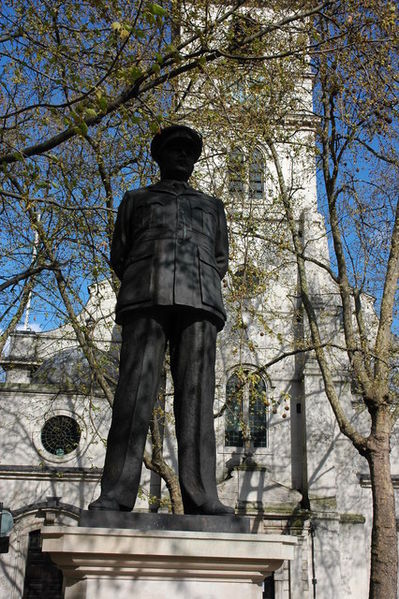 Sir Arthur Harris received a statue in front of the RAF church in St. Clemens Danes in London. Source: Philip Halling.
Sir Arthur Harris received a statue in front of the RAF church in St. Clemens Danes in London. Source: Philip Halling. The Royal Air Force Bomber Command Memorial in Green Park, London. Source: tripadvisor.
The Royal Air Force Bomber Command Memorial in Green Park, London. Source: tripadvisor. Only in 2012,the RAF Bomber Command Memorial was unveiled by Queen Elizabeth II. Source: wikipedia.
Only in 2012,the RAF Bomber Command Memorial was unveiled by Queen Elizabeth II. Source: wikipedia.Information
- Article by:
- Peter ter Haar
- Published on:
- 18-09-2015
- Last edit on:
- 30-09-2024
- Feedback?
- Send it!
Related sights
Related books
Sources
- FRIEDRICH, JöRG, De Brand, Mets & Schilt, 2004.
- HASTINGS,MAX, Bomber Command, Pan Macmillan, 2012.
- KURT VONNEGUT, Slaughterhouse five, Random House US, 1991.
- MCKEE,ALEXANDER, Dresden 1945, Zsolnay, Wenen, 1983.
- MIDDLEBROOK, M. & EVERITT, C., The Bomber Command War Diaries, Midland Publishing, 2011.
- MULISH, HARRY, Het Stenen Bruidsbed, De Bezige Bij, 2009.
- Luftangriffe auf Dresden
- Timewatch Bombing Germany / Youtube
- Various articles; strategic bombing in world war two, arthur harris,firestorm, RAF bombs, Bomber Command and others.

